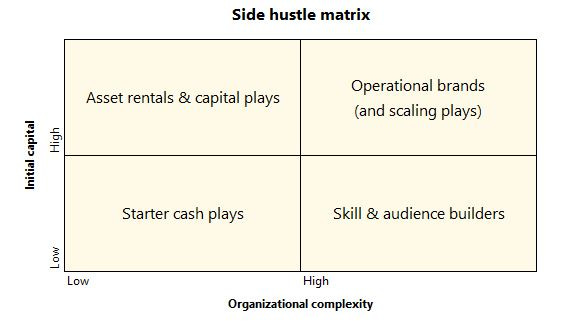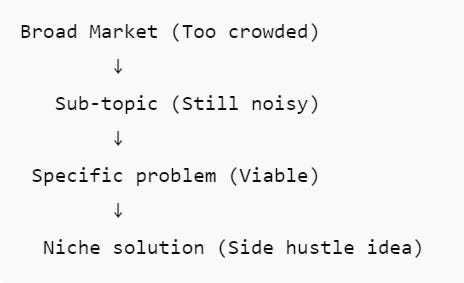How to Find Side Hustle Ideas That Actually Work
A practical guide to understanding the types of side hustles and proven ways to generate new ideas.
How do you come up with the best side hustle ideas?
The short answer: the best side hustles usually start from solving a real problem. Sometimes the problem is obvious — something you already face in your own daily life. Other times, it takes reframing or research to uncover.
But not every type of side hustle requires you to invent something new. Broadly, side hustles fall into four categories, and only half of them truly demand fresh ideas.
Starter cash plays – Quick, low-barrier gigs like tutoring, freelancing, delivery apps, or reselling. These hustles are flexible and easy to start, but offer little scalability.
Asset rentals & capital plays – Monetizing what you already own: renting a spare room on Airbnb, listing a car on Turo, licensing content, or putting a website to work. They can generate semi-passive income, but depend on existing assets.
Skill & audience builders – Hustles built on your expertise or content: courses, newsletters, YouTube channels, or niche communities. They require consistency and clear value creation for a specific audience.
Operational brands – Side hustles that look and act like small businesses: e-commerce stores, SaaS tools, or niche marketplaces. They carry higher complexity but also higher upside.
If you’d like the full breakdown of how these quadrants are defined by capital and organizational complexity, you can check our detailed framework article with the side hustle matrix.
When you don’t need to generate ideas
In some categories, originality is optional. The key is picking a model and executing it well.
Starter cash plays: These are “plug-and-play” hustles. You don’t need to invent Uber, you just need to decide if ridesharing works for your schedule and income needs. The same goes for freelancing on Fiverr or tutoring online — the path is already paved. Success depends on how you show up, not on creating a new model.
Asset rentals & capital plays: Here, the “idea” is almost built-in. If you own a spare room, a car, a camera, or even a well-trafficked website, you can rent it out or license it. The decision isn’t “what problem do I solve?” but “how do I best monetize what I already have?”.
These categories are attractive because they’re fast to start and low-risk in terms of creativity. But they also tend to have limits: low scalability, dependence on platforms, or income ceilings.
💡 This article is part of Side Hustles & Businesses — a series of practical guides to help you start and grow your next project.
If you’re reading this, you might also want to check out:
✉️ Subscribe to the newsletter to stay updated on what’s working in digital business.
When you do need fresh ideas
Other categories demand something different: originality, differentiation, and a clear problem to solve.
Skill & audience builders: A newsletter, a podcast, or an online course only succeeds if it tackles a specific gap. Teaching “marketing” is too broad. Teaching how freelance designers can price their projects better is a problem people will pay attention to. Without this focus, you’re just adding noise to an already crowded market.
Operational brands: Whether it’s a small e-commerce brand, a SaaS tool, or a niche marketplace, these models thrive only when they solve real unmet needs. Competing with Amazon or Shopify stores on generic products is a losing game. The upside here is high, but it requires insight: spotting a problem that others overlook, and building a solution around it.
Think of it this way: “fitness” is a broad market and too crowded. Narrowing down to “home workouts” is still noisy. But if you go deeper to the specific problem of “busy parents struggling to exercise at home”, you can create a niche solution like a 15-minute workout app for parents — a side hustle idea with real pull.
In short: if you’re in the starter or asset quadrants, your job is choosing and executing. If you’re in the skill or operational quadrants, your job is problem-finding. That’s where practical methods for idea generation come into play.
Where to look for problems (and side hustle ideas)
If your side hustle sits in the Skill & audience builders or Operational brands quadrants, you can’t just copy existing models. You need to find real problems that people already face. Below are seven proven places to look, with tools that make each one practical.
1. Your own frustrations
The most authentic ideas often come from problems you experience yourself. If something annoys you repeatedly, there’s a chance others feel the same.
How to use it: keep a “frustration log” on your phone or Notion. Each time you think “this is inefficient” or “this tool doesn’t do what I need”, write it down.
Why it works: you already understand the problem deeply, and you’re the first test user.
Examples:
Dropbox — Drew Houston built it after constantly forgetting his USB stick.
GoPro — Nick Woodman hacked a way to film himself surfing when no camera existed.
2. Product reviews and complaints
Customers leave raw, emotional feedback in reviews. Negative comments reveal gaps in existing solutions.
Tools to explore:
Amazon reviews – filter for 1–2 star ratings and highlight recurring complaints.
App Store / Google Play reviews – look for phrases like “wish it had…” or “too complicated.”
Trustpilot / G2 – compare pros and cons across competitors.
Why it works: people describe exactly what’s broken or missing, giving you a blueprint for improvement.
Examples:
Warby Parker — Born from complaints about $700 glasses and lack of affordable options.
Truebill (Rocket Money) — Created to cancel unused subscriptions, a top user complaint.
3. Community conversations
Niche communities are places where people vent frustrations and share unmet needs.
Tools to explore:
Reddit – search for “I hate”, “can’t find”, “is there a tool for…”.
Discord / Slack groups – observe recurring questions in professional or hobbyist channels.
Facebook groups – look at what admins answer most often.
Why it works: you see real problems in the words of the people experiencing them, not in abstract market reports.
Examples:
Canva — Melanie Perkins saw her students struggle with pro design tools.
Stack Overflow — Built after devs complained existing forums were unhelpful and closed.
4. Search data and trend signals
Search patterns reveal what people are actively looking for, sometimes before mainstream businesses catch on.
Tools to explore:
Google Trends – track rising queries over weeks and months.
Exploding Topics – curated lists of emerging topics across industries.
Ahrefs / SEMrush – see related keywords and search volumes.
Why it works: demand shows up first in searches, and if people are searching but not finding good answers, you’ve found a gap.
Examples:
Substack — Surfed the rise of the creator economy and newsletter searches.
Headspace — Tapped into the wellness boom and growing searches for meditation.
5. Reverse thinking and simplification
Sometimes the opportunity isn’t adding something new but removing friction or stripping down complexity.
How to apply:
Ask: “What can I remove?” → simplify a bloated service.
Ask: “What if I did the opposite?” → invert assumptions to spot gaps.
Map an existing process → cut unnecessary steps.
Why it works: many successful hustles thrive by being simpler than incumbents, not more complex.
Examples:
Instagram — Cut everything from Burbn except quick photo sharing.
WhatsApp — Pivoted from a status app to the simplest possible messaging tool.
6. Structured creativity methods
Formal innovation techniques like Systematic Inventive Thinking (SIT) help you systematically alter existing products or processes.
Techniques to try:
Subtraction – remove a feature and see what’s left.
Task unification – make one element serve two roles.
Attribute dependency – change one variable depending on another (e.g. price based on time).
Why it works: structured rules force you to explore ideas outside your normal intuition, uncovering unexpected opportunities.
Examples:
Zapier — Built at a hackathon to connect apps without code.
Trello — An internal tool at Fog Creek turned into a visual PM system.
7. Data-driven mining
Instead of relying only on intuition, analyze large volumes of feedback or conversations. Patterns reveal what people care about most.
Tools to explore:
Social listening tools (Brandwatch, Sprout Social) – track complaints or trending issues.
Keyword analysis – check what questions people ask on Quora or AnswerThePublic.
AI text analysis – use topic modeling or sentiment analysis on forum posts.
Why it works: data removes bias. You can validate if a frustration is widespread before investing time in building.
Examples:
Waze — Used real-time crowdsourced data from drivers to fix traffic navigation.
Cloudflare — Evolved from analyzing spam/security logs in Project Honey Pot.
FAQ
Where do the best side hustle ideas come from? The most valuable ones usually start from real problems—either problems you face yourself, or problems observed in communities and workplaces. Starting from pain points gives your idea a higher chance of solving something people will actually pay for.
Do you always need a brand-new idea? Not necessarily. Many successful projects come from improving what already exists: making it cheaper, faster, or better for a specific niche. Often, refining distribution is more powerful than inventing from scratch.
How do I know if an idea is realistic? A simple way is to test whether people are already trying to solve the problem, even with imperfect solutions. If you see money already moving in a space, it’s a sign there’s real demand.
What are the common mistakes when looking for ideas? The main traps are chasing trends without real interest, choosing ideas that don’t match your skills or time, and overlooking distribution. Many projects fail not because the product isn’t good, but because nobody discovers it.
Can I find ideas without specific skills? Yes. You can look at small daily problems in your environment, explore gig or reselling models, or partner with people who have complementary expertise.
What’s the most sustainable way to generate ideas? Building habits around observation: keeping a problem notebook, engaging with communities, and continuously asking “what feels harder than it should?” Over time, this creates a pipeline of potential side hustle opportunities.



